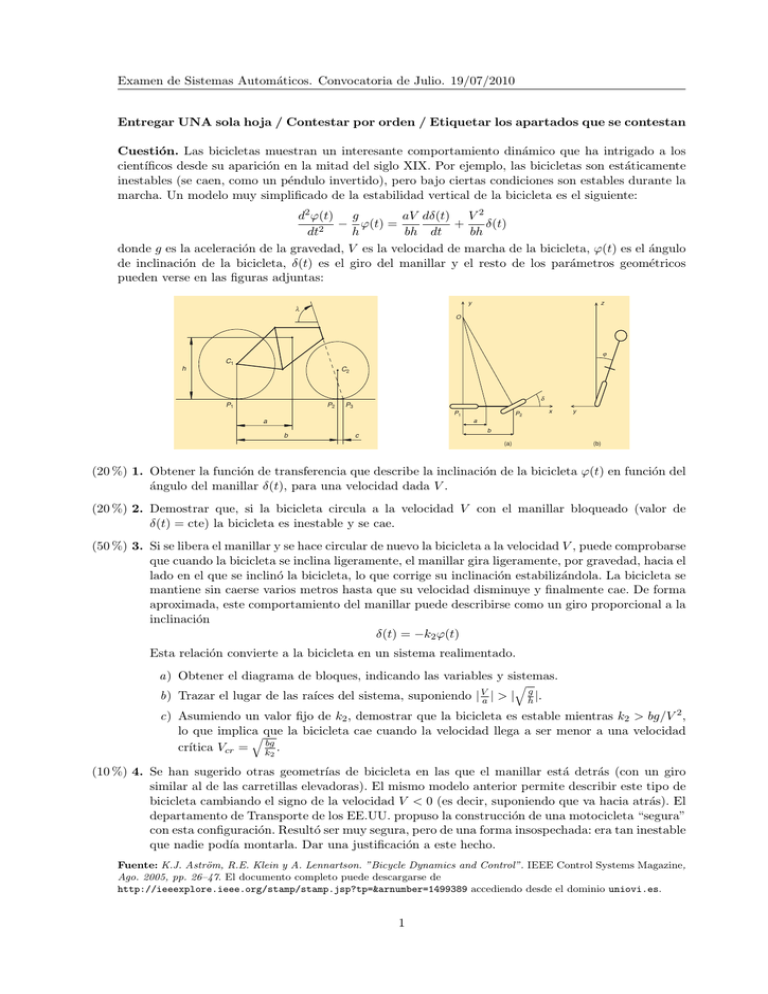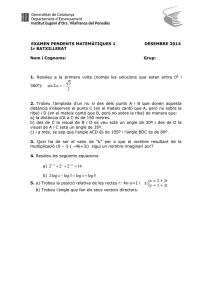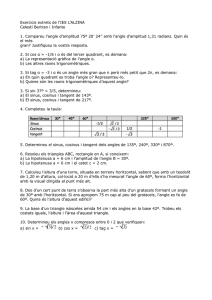Examen de Sistemas Autom´aticos. Convocatoria de Julio. 19/07/2010
Anuncio

Examen de Sistemas Automáticos. Convocatoria de Julio. 19/07/2010 Entregar UNA sola hoja / Contestar por orden / Etiquetar los apartados que se contestan Cuestión. Las bicicletas muestran un interesante comportamiento dinámico que ha intrigado a los cientı́ficos desde su aparición en la mitad del siglo XIX. Por ejemplo, las bicicletas son estáticamente inestables (se caen, como un péndulo invertido), pero bajo ciertas condiciones son estables durante la marcha. Un modelo muy simplificado de la estabilidad vertical de la bicicleta es el siguiente: the forces acting between ground and wheel. Since we do 2 tight turns, we not consider extreme conditions and assume that the bicycle tire rolls without longitudinal or 2 lateral slippage. Control of acceleration and braking is not considered explicitly, but we often assume that the forward velocity is constant. To summarize, we simply assume that the bicycle moves on a horizontal plane and that the wheels always maintain contact with the ground. Geometry 2 TheaV parameters the geometry of a bicycle d ϕ(t) g dδ(t) that Vdescribe − ϕ(t) = +1. The δ(t) are defined in Figure key parameters are wheelbase b, dt h bh dt bh head angle λ, and trail c. The front fork is angled and so that the contact point of the front wheel with donde g es la aceleración de la gravedad, V es la shaped velocidad de marcha de la bicicleta, ϕ(t) es el ángulo the road is behind the extension of the steer axis. Trail is as the horizontal distance the contact de inclinación de la bicicleta, δ(t) es el giro deldefined manillar y el resto dec between los parámetros geométricos point and the steer axis when the bicycle is upright with pueden verse en las figuras adjuntas: zero steer angle. The riding properties of the bicycle are h C1 P1 left with the roll angle ϕ as the only degree of freedom.affected All strongly by the trail. In particular, a large trail angles are assumed to be small so that the equations can improves stability but y makes steering less agile. Typical z be linearized. λ values for c range 0.03–0.08 m. Top and rear views of the bicycle are shown in Figure 3. O Geometrically, it is convenient to view the bicycle as The coordinate system xyz rotates around the vertical axis of two hinged planes, the frame plane and the with the angular velocity ω = Vδ/b, where bcomposed is the wheel frontxyz fork plane. The frame and the rear wheel lie in the base. An observer fixed to the coordinate system expeframe plane, while the front wheel lies in the front fork ϕ riences forces due to the acceleration of the coordinate system relative to inertial space. plane. The planes are joined at the steer axis. The points Let m be the total mass C of2 the system. PConsider the 1 and P2 are the contact points of the wheels with the rigid body obtained when the wheels, the rider, and the horizontal plane, and the point P3 is the intersection of the front fork assembly are fixed to the rear frame with δ = 0, steer axis with the horizontal plane (Figure 1). let J denote the moment of inertia of this body with δ respect to the x-axis, and P2let D P3= − Jxz denote the inertia Coordinates x y product with respect to the xz axes. Furthermore, let the x P1 P2 used ato analyze the system, which foland za coordinates of the center of mass be a The and h,coordinates respeclow the ISO 8855 standard, are defined in Figure 2. There tively. The angular momentum of the system with respect b c is an inertial system with axes ξ ηζ and origin O. The to the x axisb is [62] (a) (b) coordinate system xyz has its origin at the contact point dϕ dϕ VD P of the rear wheel and the horizontal plane. The x axis 1 − Dω = J Figure 3. Schematic (a) top and (b) rear views of a naive Figure 1. Parameters defining the bicycle geometry. Thedt − b δ. dt is aligned with (λ the line of contact of angle the rear plane = 0) bicycle. The steer is δ, and the with roll angle is ϕ. points P1 and P2 are the contact points of the wheels with the Lx = J (20 %) 1. Obtener la función de transferencia que describe la inclinación de also la bicicleta the horizontal plane. The x axis goes throughϕ(t) the en función del of the axis with the ground, the point P3 is the Theintersection torques acting onsteer the system are due to gravity and P3 , which point is the intersection between the steer ángulo del manillar δ(t), para una velocidad dada V . centrifugal forces, and the angular momentum balance horizontal plane, a is the distance from a vertical line through the center of mass to P1becomes , b is the wheel base, c is the trail, h is axis and the horizontal plane. Thethe orientation of thefrom steer It follows from (1) that transfer function rear wheel plane is defined by the angle ψ , which is the angle δ to tilt angle ϕ is the height of the centersi of mass, and λ is the head angle. (20 %) 2. Demostrar que, la bicicleta circula amVla velocidad conandelthemanillar (valor de 2hangle x-axis. The zbloqueado between theVξ -axis axis is d2 ϕ DV dδ J 2 − mghϕ = + δ. (1) b vertical, and y is perpendicular to x and positive on the dt δ(t) = cte) la bicicleta es inestable yb dtse cae. V(Ds + mVh) ζ = a right-hand left side of the bicycleGso that system is ϕδ (s) 2 The term mghϕ is the torque generated by gravity. The b( Js − mgh) obtained. The roll angle ϕ of the rear frame is positive ϕf mVh V (50 %) 3. Si se libera el manillar ythe seright-hand hace circular dethenuevo la a la velocidad Vfront ,s +puede comprobarse terms on side of (1) are torques gen-bicicleta s + of theaV when leaning to the right. The roll fork VD angle D ≈ a . η with the first term due to inertial erated by steering, (4) g ϕf . The steergira δ= plane ismanillar angle ligeramente, is bthe of intersection mgh que cuando la bicicleta se inclina ligeramente, el por gravedad, hacia el z J angle bh 2 s − forces and the second term due to centrifugal forces. s2 − ϕ h between the rear and front planes, positive when steerJ The model la is called the inverted pendulum modelsu inclinación estabilizándola. La bicicleta se lado en el que se inclinó bicicleta, lo que corrige left. The because of the similarity with the linearizeding equation for effective steer angle δf is the angle between lines of intersection of thethe rear and planes with mantiene sin caerse variospendulum. metros hasta quethesu velocidad disminuye yfront finalmente cae. the inverted Notice that both gain and the zero of this transfer func-De forma J ≈horizontal mh2 and plane. Approximating the moment of inertia asthe tion depend on the velocity V. aproximada, este the comportamiento del manillar puede describirse como un giro proporcional a la C2 D ≈ mah,δfthe model becomes inertia product as The model (4) is unstable and thus cannot explain why x C1 it is possible to rideModels with no hands. The system (4), howevSimple Second-Order inclinación er, can will be stabilized by activebased controlonusing the proporSecond-order models now be derived addid2Pϕ2 P3g aV dδ V2 = −k δ. tional tionalassumptions. feedback law It is assumed that the 2 ϕ(t) P1 simplifying ψ dt 2 − h ϕ = bh dt + bhδ(t) bicycle rolls on the horizontal plane, that the rider has Esta relación convierte a la bicicleta enξ un fixed sistema δ =to −kthe positionrealimentado. and orientation relative 2 ϕ, frame, and The model (1), used in [37] and [21], is a linear dynamical system of second order with two real poles that the forward velocity at the rear wheel V is constant. For simplicity, which we assume that the steersystem axis is vertical, yields the closed-loop Figure 2. Coordinate systems. The orthogonal system ξ ηζ is ! orthogo! which implies that the head angle λ is 90◦ and that the fixed to inertial space, and the ζ -axis is vertical. The mgh g g V = ±of the rear p1,2 ≈± (2) We also assume that the steer angle δ is the trail c is zero. nal system xyz has its origin at the contact point " # J h d2aϕ DVk2 dδ h mV 2hk2 control variable. The rotational associwheel with the ξ η plane. The x axis passes through the points J 2 + degree+of freedom − mgh ϕ = 0. b dt dt disappears, P1 and P3 , while the z axis is vertical and passes through P1 . ated with the front fork then andbthe system is 2 and one zero (5) a) Obtener el diagrama de bloques, indicando las variables y sistemas. � b) Trazar el lugar de las raı́ces del sistema, suponiendo | | > | |. (6) c) Asumiendo un valor fijo de k , demostrar que la bicicleta es estable mientras k2 > bg/V 2 , lo que implica cae cuando la velocidad llega a ser menor a una velocidad �que la bicicleta mVh Control V This closed-loop system is asymptotically 28 Auguststable 2005 if and only z = − IEEE ≈ − . Systems Magazine (3) bg if k2 > bg/V 2 , which is the case when V is sufficiently large. D a crı́tica Vcr = k2 . Authorized licensed use limited to: UNIVERSIDAD DE OVIEDO. Downloaded on July 15,2010 at 15:41:28 UTC from IEEE Xplore. Restrictions apply. IEEE Control Systemsque Magazine August 2005 geometrı́as de bicicleta 29 (10 %) 4. Se han sugerido otras en las el manillar está detrás (con un giro Authorized licensed use limited to: UNIVERSIDAD DE OVIEDO. Downloaded on July 15,2010 at 15:41:28 UTC from IEEE Xplore. Restrictions apply. similar al de las carretillas elevadoras). El mismo modelo anterior permite describir este tipo de bicicleta cambiando el signo de la velocidad V < 0 (es decir, suponiendo que va hacia atrás). El departamento de Transporte de los EE.UU. propuso la construcción de una motocicleta “segura” con esta configuración. Resultó ser muy segura, pero de una forma insospechada: era tan inestable que nadie podı́a montarla. Dar una justificación a este hecho. Fuente: K.J. Aström, R.E. Klein y A. Lennartson. ”Bicycle Dynamics and Control”. IEEE Control Systems Magazine, Ago. 2005, pp. 26–47. El documento completo puede descargarse de http://ieeexplore.ieee.org/stamp/stamp.jsp?tp=&arnumber=1499389 accediendo desde el dominio uniovi.es. 1 Nombre, Apellidos: ____________________________________________ Julio 2010 D.N.I.: _____________________ Sistemas Automáticos La figura representa el diagrama de Bode de la función de transferencia en cadena abierta G(s), de un sistema de realimentación unitaria. Se pide: Ki de forma que el sistema s en cadena cerrada presente un error ev!0.05 ante una rampa unitaria y un MF!45º. (6 puntos) 2. Dibujar el diagrama de Bode del controlador diseñado. (2 puntos) 3. Obtener el algoritmo de control (ecuación en diferencias) utilizando la discretización del controlador diseñado, tomando como transformación 1 ! z !1 s= , siendo T el periodo de muestreo. (2 puntos) T 1. Diseñar el regulador PI definido por D( s ) = K p + Julio Sistemas Automáticos 19 Julio 2010 4 Ingenierı́a Industrial Nombre y apellidos: Responda razonadamente y con letra clara a las cuestiones propuestas, utilizando el espacio proporcionado. No está permitido el uso de calculadora. 1. (2.5 pt.) Dado el sistema: U (s) U ∗ (s) = e−0,0314s ∠U(s)/U*(s) (°) |U(s)/U*(s)| (dB) a. Dibuje su diagrama de Bode en el recuadro adjunto. 10 10 10 10 10 Frecuencia (rad/s) b. Si a este sistema se le suministra como entrada la señal de la figura u∗ (t), represente de forma aproximada, en la misma gráfica, cómo serı́a la respuesta u(t) en régimen permanente. 2 1.5 1 u*(t) 0.5 0 −0.5 −1 −1.5 −2 0 0.01 0.02 0.03 0.04 0.05 0.06 0.07 0.08 0.09 0.1 tiempo (s) c. Exponga al menos tres ejemplos de sistemas que incorporen una función de transferencia similar a la enunciada. El ejercicio continúa en la página siguiente. Página 1 de 2 Sistemas Automáticos Julio (cont.) 4 Ingenierı́a Industrial 2. (2.5 pt.) (a) Explique en qué consiste el problema del windup. (b) Esquematice en un diagrama de bloques una posible solución. 3. (2.5 pt.) Explique, de forma razonada, qué ocurre si el ancho de banda del sensor realmente utilizado para medir la variable a controlar no es mucho mayor que el ancho de banda del sistema controlado, para cuyo diseño se utilizó un sensor ideal. 4. (2.5 pt.) Una técnica para sintonizar reguladores es el modelado de la función de lazo. Explique las relaciones de la función de lazo con el sistema realimentado que permiten dicho procedimiento. Fin del ejercicio. No olvide escribir su nombre y apellidos en todas las hojas antes de entregar. Página 2 de 2

